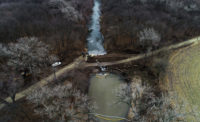Natural Disasters
Maui Wildfire Cleanup Could Cost $1B and Take One Year

Photo by Patrick Moes/U.S. Army Corps of Engineers Honolulu District
Hawaii Gov. Josh Green and Sen. Brian Schatz (D-Hawaii) have estimated at $1 billion the cost of cleanup after the Maui wildfires—which started Aug. 8 and killed at least 115 people and destroyed more than 2,200 structures. Officials planning the rebuilding of the parts of West Maui devastated by the wildfires are emphasizing safety and residents’ wishes over speed.
Debris removal alone is expected to take nearly a year, according to Green. The U.S. Environmental Protection Agency is leading the cleanup’s first phase, which includes removal of hazardous material such as pesticides, batteries, asbestos and pressurized tanks. Work began late last month. Green said during a Sept. 8 briefing that he expects it to take three or four months.
State officials selected the U.S. Army Corps of Engineers to lead the second phase of debris and ash removal. A big concern is the capacity of Maui's single landfill to accept the ruins of the fires. The county will likely need to expand its landfill capacity, says Chad Goodfellow, CEO of Maui-based contractor Goodfellow Bros.
Questions remain about the rebuild. Green initially said a state emergency housing task force established this summer before the fires would lead rebuilding efforts in Lahaina, but walked back that plan following objections from residents. The state’s chief housing officer announced her resignation this month. Potential changes to the local building code and the threat of sea level rise could also prevent a one-for-one replacement.
“The people of Maui must have as much time as they need to heal and recover,” Green said at a Sept. 8 briefing. “We’ll begin to rebuild only when they’re ready according to the timeline they choose.”
When rebuilding does begin, it appears that contractors will have a large labor pool, says Goodfellow. Many people out of work as a result of the fires have been reaching out and started training. A recent University of Hawaii analysis found more than 11% of Maui residents employed before the fires have since filed for unemployment.
Many burnt buildings may contain materials now known to be unsafe, such as asbestos, lead paint and fiberboard treated with arsenic, according to the Hawaii State Dept. of Health.
Residents and business owners will not be able to schedule visits to their property and survey damage until the phase-one cleanup is complete. “The ash, we are told, is quite toxic,” Green said. “So we need to be careful.”
Maui police and the FBI say at least 66 people are still missing. Local officials say 99% of the Lahaina disaster area has been searched, but the remains of at least some of those people may still be in the debris. Lt. Col. Ryan Pevey, commander of the Corps’ Honolulu District, said in a statement that it would work with cultural advisors to develop a process that respects the families and the communities’ indigenous and multicultural history.
Goodfellow says contractors who would normally be competitors have come together to help each other solve their challenges. “In the darkness of this tragedy, there is a light that comes from this community rallying together not just to support each other, but make sure that we rebuild this place and do it in a culturally sensitive and kind way,” he says.




